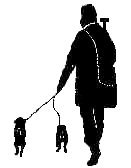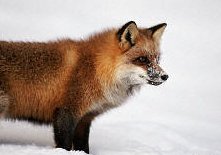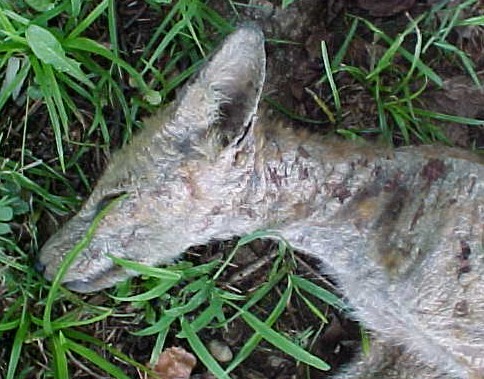
.
Quarry & Others
America is blessed with many kinds of quarry that can be worked year round: groundhog, raccoon, red fox, possum, gray fox, and badger. Most quarry is at record levels of abundance, and most folks in the Eastern U.S. and Midwest live within a half hour of excellent hunting opportunities. To hunt successfully, you need to know the animal and its wants and needs. >> To read more
 The
Measured Size of Red Fox
The
Measured Size of Red Fox The Eastern red fox is an immigrant to the U.S. imported from the UK. Not surprisingly, our animal is exactly the same size as its European cousin. Dr. Paolo Cavallini goes through the data on red fox size all over the world and finds chest measurements are surprisingly consistent -- and surprisingly small. >> To read more
Want to "explode the code" of your working dog while you are sitting at your computer and your dog is sleeping at your feet? Play these sounds of groundhog, raccoon, and red fox, and your dogs may jump up and bite the speakers! Many dogs that have never worked quarry before will react with incredible interest to these sounds. We even have the sound of a skunk! >> To hear more
David MacDonald is a hunter at heart, albeit a hunter equipped with a Yagi directional-antenna in one hand, and a pair of infra-red binoculars in the other. After more than 25 years of tracking red foxes through farm, fell, forest, suburb, desert and inner city, he is also the preeminent fox biologist in the world. Running With the Foxes is his masterpiece, and it contains suprising bits of information.
>> To read more
Underneath a coat of luxuriant black and white fur, the stripped skunk weighs just a few pounds and lives on a diet of beetle grubs and worms. Despite it's small size, however, the skunk is one of the most serious threats to the life of a working terrier. If a dog is sprayed underground, it can be overwhelmed, lose consciousness and die from toxic shock. Even if a dog survives, it may perish from anemia later on. With skunks, the smell can be the least of your problems. >> To read more
About three-fourths of all groundhogs do not survive their first year, and about one-third of adults perish every year as well. The single greatest killer of adult groundhogs appears to be pneumonia -- groundhogs burrow in for the winter and perish from lung infections brought on by cold, wet dens. >> To read more
Underneath their fur, red fox, raccoon, gray fox, and groundhogs are small animals with chests no bigger around than a one-liter Coke bottle (i.e. they have chests that are about 14 inches around). A look at taxidermy manikins can tell you a lot about working terriers -- and why most Kennel Club terriers are never found working in the field.
>> To read more
If you don't know the difference between fox feces and dog dirt, you don't know squat! Take this interactive test to see if you can tell the difference between raccoon poop and goose dung. Amaze your friends and confirm the worst fears of your enemies. >> To take the test
 Mange in Red Fox
Mange in Red FoxIf left uncontrolled by trapping, predation or collisions with cars, fox populations will climb to carrying capacity, at which point they will rise and fall with seasonal fluctuations in food sources (i.e. many young animals will starve), or epidemics of disease (rabies, distemper and mange). Mange is a particularly ugly and common disease among red fox. >> To read more
A quick look at skulls can give you some idea of the relative size differential between various types of den-dwelling animals that American terriers might encounter in the field. Shot from above in a group, and shot from the side in pairs, these skulls provide a lesson in comparative taxonomy. >> To see more
Terrierwork follows a corn season, with fox pups tottering out of natal dens just as corn is planted. While corn and fox pups are growing, American terriers work groundhogs, possum and raccoons. When the corn is taken off, the search for fox dens begins. Freezing cold, icy rain,and strong winds all increase the odds of finding a fox at home >> To read more
